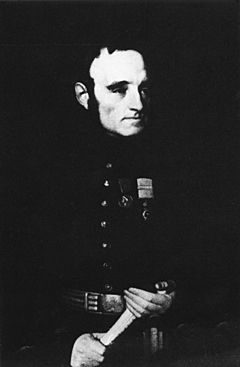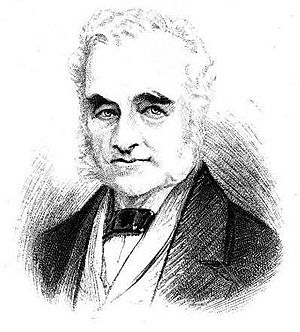George Gawler facts for kids
Quick facts for kids
George Gawler
KH
|
|
|---|---|
 |
|
| 2nd Governor of South Australia | |
| Preceded by | John Hindmarsh |
| Succeeded by | George Grey |
| Personal details | |
| Born | 21 July 1795 |
| Died | 7 May 1869 Southsea |
| Resting place | Portsmouth |
| Spouse | Maria |
| Occupation | Army officer, Colonial administrator |
| Awards | Knight of the Royal Guelphic Order |
| Military service | |
| Allegiance | Great Britain (1793-1801) United Kingdom (1801-1846) |
| Branch/service | |
George Gawler (born 21 July 1795 – died 7 May 1869) was an important British army officer. He is best known for being the second Governor of South Australia. He served in this role from October 17, 1838, to May 15, 1841.
Contents
Biography
Early Life and Military Career
George Gawler was the only child of Captain Samuel Gawler and Julia Russell. His father, a captain in the army, was killed in India in 1804. George grew up in Devon, England. He was taught by a private teacher and later attended a military college in Great Marlow.
In 1810, George Gawler joined the 52nd Regiment of Foot as an ensign. In 1812, he went to fight in the Peninsular War in Spain. He was injured during a battle in Badajoz but was saved by another soldier. He stayed in Spain until 1814. Later, as a lieutenant, he fought in the famous Battle of Waterloo in 1815. After the war, he remained in France with the army until 1818.
In 1820, George Gawler married Maria Cox. Both George and Maria were very religious. When his regiment was sent to New Brunswick in 1823, they did a lot of social and religious work there. Gawler returned to England in 1826. He became a lieutenant-colonel in 1834. In 1837, he received an award called the Royal Hanoverian Guelphic Order.
Governor of South Australia
In 1838, George Gawler was chosen to be the governor of South Australia. He took over from the first governor, Captain John Hindmarsh. Gawler, his wife, and their children arrived in South Australia on October 12, 1838, after a four-month journey.
When Gawler arrived, the colony was in trouble. There wasn't enough money, and many of the 4,000 immigrants were living in poor conditions. Gawler was allowed to spend up to £12,000 a year, with an extra £5,000 for emergencies. His main goal was to help the colony grow by encouraging farming and production.
He asked Charles Sturt, a famous explorer, to come from New South Wales to help survey the land. The previous surveyor, Colonel William Light, had resigned due to poor health. Gawler also hired more government officials, created a police force, and improved the port at Port Adelaide. The first permanent Government House was built during his time as governor.
Challenges and Achievements
By 1840, the cost of living in South Australia went up very quickly. This was partly because of droughts in other Australian colonies. South Australia was not yet growing enough food for itself. Gawler spent more money to help the colony, but eventually, the economy faced serious problems. Over £200,000 had been spent, and the money fund in London was empty.
The British Parliament approved a loan of £155,000 to help South Australia. Later, this loan was changed into a gift. Captain George Grey was sent to replace Gawler as governor.
Even though he faced difficulties, Governor Gawler helped South Australia become self-sufficient in farming. He also brought back confidence to the people living there. Many people at the time, including Charles Sturt, believed that Gawler's leadership greatly helped the settlement. Later investigations showed that Gawler was truly one of the important founders of South Australia.
What is George Gawler Remembered For?
In 1845, Gawler wrote a book suggesting that Jewish people should be allowed to create farming settlements in the Land of Israel. This was meant to help them after their suffering in Europe and under Turkish rule. In 1849, he visited Israel with Moses Montefiore. In 1852, he started an association to help with the settlement of Palestine. Gawler died in Southsea, England, and was buried in Portsmouth.
Several places in Australia are named after him. The town of Gawler was named after him because it was surveyed soon after he arrived. The Gawler Ranges in South Australia are also named in his honor.
Gawler also contributed to the Derby's Town and County Museum in the 1830s. He gave them a collection of minerals and stuffed exotic birds, including an albatross, which he collected during his time as governor.
Related pages
- Joseph Whittaker - Gawler's gardener in Australia
| Preceded by Captain John Hindmarsh, KH, RN |
Governor of South Australia 1838–1841 |
Succeeded by Sir George Edward Grey KCB |


